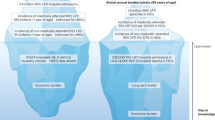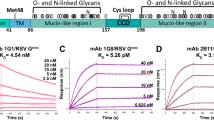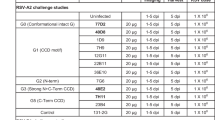Abstract
We transferred the complementarity determining regions from a murine monoclonal antibody that neutralizes infection by respiratory syncytial virus (RSV) to a human IgG1 monoclonal antibody. The resulting reshaped human antibody lost affinity for RSV, but an additional alteration to one of the framework regions restored binding affinity and specificity. This second generation reshaped human monoclonal antibody cross-reacted with all clinical isolates of RSV tested and both prevented disease and cured mice even when administered four days after infection. We expect the antibody will prove useful in the management of this major childhood disease.
This is a preview of subscription content, access via your institution
Access options
Subscribe to this journal
Receive 12 print issues and online access
$259.00 per year
only $21.58 per issue
Buy this article
- Purchase on SpringerLink
- Instant access to full article PDF
Prices may be subject to local taxes which are calculated during checkout
Similar content being viewed by others
References
Brandt, C.D., Kim, H.W., Orrobio, J.O., Jeffries, B.C., Wood, S.C., Chanock, R.M. and Parrott, R.H. 1973. Epidemiology of respiratory syncytial virus infection in Washington DC III. Composite analysis of eleven consecutive yearly epidemics. Am. J. Epidemiol. 98: 355–364.
Sims, D.G., Downham, M.A.P.S., McQuillin, J. and Gardner, P.S. 1976. Respiratory syncytial virus infection in north-east England. Br. Med. J. 2: 1095–1098.
Bruhn, F.W. and Yeager, A.G. 1977. Respiratory syncytial virus in early infancy. Am. J. Dis. Child. 131: 145–148.
Wright, P.F., Belshe, R.B., Kim, H.W., Van Voris, L.P. and Chanock, R.M. 1982. Administration of a highly attenuated live respiratory syncytial virus vaccine to adults and children. Infect. Immun. 37: 397–400.
Conrad, D.A., Christenson, J.C., Waner, J.L. and Marks, M.I. 1987. Aerosolized ribavirin treatment of respiratory syncytial virus infection in infants hospitalised during an epidemic. Pediatr. Infect. Dis. J. 6: 152–158.
Ogilvie, M.M., Vathenen, A.S., Radford, M., Codd, J. and Key, S. 1981. Maternal antibody and respiratory syncytial virus infection in infancy. J. Med. Virol. 7: 263–271.
Hemming, V.G., Rodriguez, W., Kim, H.W., Brandt, C.D., Parrott, R.H., Burch, B., Prince, G.A., Baron, P.A., Fink, R.J. and Reaman, G. 1987. Intravenous immunoglobulin treatment of respiratory syncytial virus infections in infants and young children. Anti. Agents and Chemotherapy 31: 1882–1886.
Hemming, V.G., Prince, G.A., Horswood, R.L., London, W.T., Murphy, B.R., Walsh, E.E., Fischer, G.W., Weisman, L.E., Baron, P.A. and Chanock, R.M. 1985. Studies of passive immunotherapy for infections of respiratory syncytial virus in the respiratory tract of a primate model. J. Infect. Dis. 152: 1083–1087.
Prince, G.A., Hemming, V.G., Horswood, R.L. and Chanock, R.M. 1985. Immunoprophylaxis and immunotherapy of respiratory syncytial virus infection in the cotton rat. Virus Res. 3: 193–206.
Taylor, G., Stott, E.J., Bew, M., Fernie, B.F., Cote, P.J., Collins, A.P., Hughes, M. and Jebbett, J. 1983. Monoclonal antibodies protect against respiratory syncytial virus infection in mice. Immunology 52: 137–142.
Stott, E.J. and Taylor, G. 1989. Immune Responses, Virus Infections and Disease, p. 85–104. N. J. Dimmock and P. D. Minor (Eds.). I.R.L. Press, London.
Benjamin, R.J., Cobbold, S.P., Clark, M.R. and Waldmann, H. 1986. Tolerance of rat monoclonal antibodies: implications for serotherapy. J. Exp. Med. 163: 1539–1544.
Brüggemann, M., Winter, G., Waldmann, H. and Neuberger, M. 1989. The immunogenicity of chimeric antibodies. J. Exp. Med. 170: 2153–2157.
Morrison, S.L., Johnson, M.J., Herzenberg, L.A. and Oi, V. 1984. Chimeric human antibody molecules: mouse antigen-binding domains with human constant region domains. Proc. Natl. Acad. Sci. USA 81: 6851–6855.
Jones, P.T., Dear, P.H., Foote, J., Neuberger, M. and Winter, G. 1986. Replacing the complementarity determining regions in a human antibody with those from a mouse. Nature 321: 522–525.
Kabat, E.A., Wu, T.T., Reid-Miller, M., Perry, H.M. and Gottes-man, K.S. 1987. Sequences of proteins of immunological interest (U.S. Dept of Health and Human Services, U.S. Government Printing Office).
Saul, F.A., Amzel, M. and Poljak, R.J. 1978. Preliminary refinement and structural analysis of the Fab fragment from human immunoglob-ulin NEW. J. Biol. Chem. 253: 585–597.
Epp, O., Colman, P., Fehlammer, H., Bode, W., Schiffer, M. and Huber, R. 1974. Crystal and molecular structure of a dimer of the variable poru'ons of the Bence-Jones protein REI. Eur. J. Biochem. 45: 513–524.
Riechmann, L., Clark, M., Waldmann, H. and Winter, G. 1988. Reshaping human antibodies for therapy. Nature 332: 323–327.
Nakamaya, K. and Eckstein, F. 1986. Inhibition of restriction endo-nuclease NciI cleavage by phosphothiorate groups and its application to oligonucleotide-directed mutagenesis. Nuc. Acids Res. 14: 9679–9698.
Orlandi, R., Güssow, D.H., Jones, P.T. and Winter, G. 1989. Cloning immunoglobulin variable domains for expression by the polymerase chain reaction. Proc. Natl. Acad. Sci. USA 86: 3833–3837.
Chothia, C. and Lesk, A.M. 1987. Canonical structures for the hypervariable regions of immunoglobulins. J. Mol. Biol. 196: 901–917.
Steinitz, M., Klein, G., Koskimies, S. and Makela, O. 1977. EB virus induced B lymphocyte cell lines producing specific antibody. Nature 269: 420–422.
Steinitz, M., Koskimies, S., Klein, G. and Makela, O. 1979. Establishment of specific antibody producing human lines by antigen preselection and Epstein-Barr virus (EBV)-transformation. J. Clin. Lab. Immunol. 2: 1–4.
Larrick, J.W. and Bourla, J.M. 1986. The prospects for the therapeutic use of human monoclonal antibodies. J. Biol. Response Modif. 5: 379–393.
James, K. and Bell, G.T. 1987. Human monoclonal antibody production. J. Immunol. Meth. 100: 5–40.
Neuberger, M. 1985. Making novel antibodies by expressing trans-fected immunoglobulin genes. Trends in Biochem. Sci. 10: 347–349.
Brüggeman, M., Williams, G.T., Bindon, C.I., Clark, M.R., Jefferis, R., Waldmann, H. and Neuberger, M. S. 1987. Comparison of the effector functions of human immunoglobulins using a matched set of chimaeric antibodies. J. Exp. Med. 166: 1351–1361.
Neuberger, M.S., Williams, G.T. and Fox, R.O. 1984. Recombinant antibodies possessing novel effector functions. Nature 312: 604–608.
Queen, C., Schneider, W.P., Selick, H.E., Payne, P.W., Landolfi, N.F., Duncan, J.F., Avdalovic, N.M., Levitt, M., Junghans, R.P. and Waldmann, T.A. 1989. A humanised antibody that binds interleukin 2 receptor. Proc. Natl. Acad. Sci. USA 86: 10029–10033.
Hale, G., Clark, M.R., Marcus, R., Winter, G., Dyer, M.S., Phillips, J.M., Riechmann, L. and Waldmann, H. 1988. Remission induction in non-Hodgkin lymphoma with reshaped human monoclonal antibody Campath-1 H. Lancet ii: 1394–1398.
Kilmartin, J.V., Wright, B. and Milstein, C. 1982. Rat monoclonal antitubulin antibodies derived by using a new non-secreting rat cell line. J. Cell Biol. 93: 576–582.
Favaloro, J., Treisman, R. and Kamen, R. 1980. Transcription maps of polyoma-virus specific RNA: analysis by two dimensional S1-gel mapping. Methods in Enzymol. 65: 718–749.
Takahashi, N., Veda, S., Obatu, M., Nikaido, T., Nakai, S. and Honjo, T. 1982. Structure of human immunoglobulin gamma genes: implications for evolution of a gene family. Cell 29: 671–679.
Hieter, P.A., Max, E.E., Seidman, J.G., Maizel, J.V., Jr. and Leder, P. 1980. Cloned human and mouse kappa immunoglobulin constant and J region genes conserve homology in functional segments. Cell 22: 197–207.
Author information
Authors and Affiliations
Rights and permissions
About this article
Cite this article
Tempest, P., Bremner, P., Lambert, M. et al. Reshaping a Human Monoclonal Antibody to Inhibit Human Respiratory Syncytial Virus Infection in Vivo. Nat Biotechnol 9, 266–271 (1991). https://doi.org/10.1038/nbt0391-266
Received:
Accepted:
Issue date:
DOI: https://doi.org/10.1038/nbt0391-266
This article is cited by
-
Prevention of serious respiratory syncytial virus-related illness. II: Immunoprophylaxis
Advances in Therapy (2011)
-
The biotechnology and applications of antibody engineering
Molecular Biotechnology (1995)



